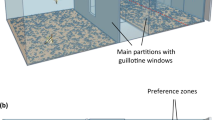Abstract
The ability to quantify, i.e. to estimate quantity, may provide evolutionary advantages in some contexts and has been demonstrated in a variety of animal species. In a prior study, we showed that angelfish (Pterophyllum scalare) were able to discriminate between groups (shoals) in which a large number of conspecifics swam preferring to join the larger of the two. Our results implied that angelfish can compare relative shoal sizes likely on the basis of some quantitative attributes of the shoal. Here, also using a binary preference test, we examined whether angelfish are able to discriminate between shoals of small numbers of conspecifics, and if so whether their performance reveals a comparable underlying mechanism to that proposed for discrimination of small quantities in human and non-human animals, namely the possible precursor of the ability to count. Our results demonstrate that fish reliably chose 4 versus 1, 3 versus 1, 2 versus 1 and 3 versus 2 individuals, but were at chance performance level when having to choose between 4 versus 3, 5 versus 4 and 6 versus 5. Findings also reveal that the density of the fish in the stimulus shoals did not significantly affect the performance of experimental angelfish. These results are compatible with the hypothesis of the existence of an object-file mechanism to discriminate small quantities in vertebrates and provide evidence for spontaneous discrimination of up to three elements in angelfish, a similar limit to that found in human and non-human animals. The findings add to the growing body of data, suggesting that the mechanisms underlying discrimination between different quantities of items may be shared across different taxa and have an evolutionary ancient origin.



Similar content being viewed by others
References
Addessi E, Crescimbene L, Visalberghi E (2008) Food and token quantity discrimination in capuchin monkeys (Cebus apella). Anim Cogn 11:275–282
Agrillo C, Dadda M (2007) Discrimination of the larger shoal in the poeciliid fish Girardinus falcatus. Ethol Ecol Evol 19:145–157
Agrillo C, Dadda M, Bisazza A (2006) Sexual harassment influences group choice in female mosquitofish. Ethology 112:592–598
Agrillo C, Dadda M, Bisazza A (2007) Quantity discrimination in female mosquitofish. Anim Cogn 10:63–70
Agrillo C, Dadda M, Serena G (2008a) Choice of female groups by male mosquitofish (Gambusia holbrooki). Ethology 118:479–488
Agrillo C, Dadda M, Serena G, Bisazza A (2008b) Do fish count? Spontaneous discrimination of quantity in female mosquitofish. Anim Cogn 11:495–503
Agrillo C, Dadda M, Serena G, Bisazza A (2009) Use of number by fish. PLoS ONE 4:e4786. doi:10.1371/journal.pone.0004786
Al Aïn S, Giret N, Grand M, Kreuitzer M, Bovet D (2009) The discrimination of discrete and continuous amounts in African grey parrots (Psittacus erithacus). Anim Cogn 12:145–154
Barber I, Wright HA (2001) How strong are familiarity preferences in shoaling fish? Anim Behav 61:973–979
Binoy VV, Thomas KJ (2004) The climbing perch (Anabas testudineus Bloch), a freshwater fish, prefers larger unfamiliar shoals to smaller familiar shoals. Curr Sci 86:207–211
Bisazza A, Piffer L, Serena G, Agrillo C (2010) Ontogeny of numerical abilities in fish. PLoS ONE 5:e15516. doi:10.1371/journal.pone.0015516
Bonanni R, Natoli E, Cafazzo S, Valsecchi P (2011) Free-ranging dogs assess the quantity of opponents in intergroup conflicts. Anim Cogn 14:103–115
Bradner J, McRobert SP (2001) The effect of shoal size on patterns of body colour segregation in mollies. J Fish Biol 59:960–967
Buckingham JN, Wong BBM, Rosenthal GG (2007) Shoaling decisions in female swordtails: how do fish gauge group size? Behaviour 144:1333–1346
Cantlon JF, Brannon EM (2006) Shared system for ordering small and large numbers in monkeys and humans. Psycho Sci 17:401–406
Carazo P, Font E, Forteza-Behrendt E, Desfilis E (2009) Quantity discrimination in Tenebrio molitor: evidence of numerosity discrimination in an invertebrate? Anim Cogn 12:463–470
Clearfield MW, Mix KS (1999) Number versus contour length in infants’ discrimination of small visual sets. Psychol Sci 10:408–411
Cordes S, Brannon EM (2008a) The difficulties of representing continuous extent in infancy: using number is just easier. Child Devel 79:476–489
Cordes S, Brannon EM (2008b) Quantitative competences in infancy. Dev Sci Rev 11:803–808
Cordes S, Brannon EM (2009) Crossing the divide: infants discriminate small from large numerosities. Dev Psychol 45:1583–1594
Creswell W, Quinn JL (2004) Faced with a choice, sparrowhawks more often attack the more vulnerable prey group. Oikos 104:71–76
Dadda M, Piffer L, Agrillo C, Bisazza A (2009) Spontaneous number representation in mosquitofish. Cognition 122:343–348
Emmerton J (1998) Numerosity differences and effects of stimulus density on pigeons’ discrimination performance. Anim Learn Behav 26:243–256
Emmerton J, Renner JC (2006) Scalar effects in the visual discrimination of numerosity by pigeons. Learn Behav 34:176–192
Emmerton J, Renner JC (2009) Local rather than global processing of visual arrays in numerosity discrimination by pigeons (Columba livia). Anim Cogn 12:511–526
Feigenson L, Carey S (2003) Tracking individuals via object files: evidence from infants’ manual search task. Develop Sci 6:568–578
Feigenson L, Carey S (2005) On the limits of infants’ quantification of small object arrays. Cognition 97:295–313
Feigenson L, Carey S, Hauser MD (2002a) The representations underlying infants’ choice of more: object files vs. analog magnitudes. Psychol Sci 13:150–156
Feigenson L, Carey S, Spelke ES (2002b) Infants’ discrimination of number vs. continuous extent. Cogn Psychol 44:33–66
Feigenson L, Dehaene S, Spelke E (2004) Core systems of number. Trends Cogn Sci 8:307–314
Frommen JG, Hiermes M, Bakker TCM (2009) Disentangling the effects of group size and density on shoaling decisions of three-spined sticklebacks (Gasterosteus aculeatus). Behav Ecol Sociobiol 63:1141–1148
Gallistel CR, Gelman R (2000) Non-verbal numerical cognition: from the reals to the integers. Trends Cogn Sci 4:59–65
Gómez-Laplaza LM, Fuente A (2007) Shoaling decisions in angelfish: the roles of social status and familiarity. Ethology 113:847–855
Gómez-Laplaza LM, Gerlai R (2011) Can angelfish (Pterophyllum scalare) count? Discrimination between different shoal sizes follows Weber’s law. Anim Cogn 14:1–9
Hager MC, Helfman GS (1991) Safety in numbers: shoal size choice by minnows under predatory threat. Behav Ecol Sociobiol 29:271–276
Halberda J, Mazzocco MM, Feigenson L (2008) Individual differences in non-verbal number acuity correlate with maths achievement. Nature 455:665–668
Hanus D, Call J (2007) Discrete quantity judgments in the great apes (Pan paniscus, Pan troglodytes, Gorilla gorilla, Pongo pygmaeus): the effect of presenting whole sets versus item-by-item. J Comp Psychol 121:241–249
Hauser MD, Carey S (2003) Spontaneous representations of small numbers of objects by rhesus macaques: examinations of content and format. Cogn Psychol 47:367–401
Hauser MC, Spelke ES (2004) Evolutionary and developmental foundations of human knowledge. In: Gazzaniga M (ed) The cognitive neurosciences III. MIT Press, Cambridge, pp 853–864
Hauser MD, Carey S, Hauser L (2000) Spontaneous number representation in semi-free-ranging rhesus monkeys. Proc R Soc B 267:829–833
Hoare DJ, Couzin ID, Godin J-GJ, Krause J (2004) Context-dependent group size choice in fish. Anim Behav 67:155–164
Kilian A, Yaman S, von Fersen L, Güntürkün O (2003) A bottlenose dolphin discriminates visual stimuli differing in numerosity. Learn Beahv 31:133–142
Krause J, Ruxton GD (2002) Living in groups. Oxford University Press, Oxford
Krusche P, Uller C, Dicke U (2010) Quantity discrimination in salamanders. J Exp Biol 213:1822–1828
Lewis KP, Jaffe S, Brannon EM (2005) Analog number representations in mongoose lemurs (Eulemur mongoz): evidence from a search task. Anim Cogn 8:247–252
Lyon BE (2003) Egg recognition and counting reduce costs of avian conspecific brood parasitism. Nature 422:495–499
Miller N, Gerlai R (2008) Oscillations in shoal cohesion in zebrafish (Danio rerio). Behav Brain Res 193:148–151
Odell NS, Eadie JM (2010) Do wood ducks use the quantity of eggs in a nest as a cue to the nest’s value? Behav Ecol 21:794–801
Pisa PE, Agrillo C (2009) Quantity discrimination in felines: a preliminary investigation of the domestic cat (Felis silvestris catus). J Ethol 27:289–293
Pitcher TJ, Parrish JK (1993) Functions of shoaling behaviour in teleosts. In: Pitcher TJ (ed) Behaviour of teleost fishes, 2nd edn. Chapman and Hall, London, pp 363–439
Pritchard VL, Lawrence J, Butlin RK, Krause J (2001) Shoal choice in zebrafish, Danio rerio: the influence of shoal size and activity. Anim Behav 62:1085–1088
Rugani R, Regolin L, Vallortigara G (2008) Discrimination of small numerosities in young chicks. J Exp Psychol Anim Behav Process 34:388–399
Rugani R, Fontanari L, Simoni E, Regolin L, Vallortigara G (2009) Arithmetic in newborn chicks. Proc R Soc B 276:2451–2460
Snekser JL, McRobert SP, Clotfelter ED (2006) Social partner preferences of male and female fighting fish (Betta splendens). Behav Proc 72:38–41
Stephens D, Krebs J (1986) Foraging theory. Princeton University Press, Princeton
Stevens JR, Wood J, Hauser MD (2007) When quantity trumps number: discrimination experiments in cotton-top tamarins (Saguinus oedipus) and common marmosets (Callithrix jacchus). Anim Cogn 10:429–437
Tegeder RW, Krause J (1995) Density dependence and numerosity in fright stimulated aggregation behaviour of shoaling fish. Phil Trans R Soc Lond B 350:381–390
Trick LM, Pylyshyn ZW (1994) Why are small and large numbers enumerated differently? A limited-capacity preattentive stage in vision. Psychol Rev 101:80–102
Uller C, Lewis J (2009) Horses (Equus caballus) select the greater of two quantities in small numerical contrasts. Anim Cogn 12:733–738
Uller C, Jaeger R, Guidry G, Martin C (2003) Salamanders (Plethodon cinereus) go for more: rudiments of number in an amphibian. Anim Cogn 6:105–112
vanMarle K, Wynn K (2009) Infants’ auditory enumeration: evidence for analog magnitudes in the small number range. Cognition 111:302–316
Ward C, Smuts B (2007) Quantity based judgments in the domestic dog (Canis lupus familiaris). Anim Cogn 10:71–80
Wilson ML, Hauser MD, Wrangham RW (2001) Does participation in intergroup conflict depend on numerical assessment, range location, or rank for wild chimpanzees? Anim Behav 61:1203–1216
Wong BBM, Rosenthal GG (2005) Shoal choice in swordtails when preferences conflict. Ethology 111:179–186
Wood JN, Hauser MD, Glynn DD, Barner D (2008) Free-ranging rhesus monkeys spontaneously individuate and enumerate small numbers of non-solid portions. Cognition 106:207–221
Xu F (2003) Numerosity discrimination in infants: evidence for two systems of representations. Cognition 89:B15–B25
Xu F, Spelke ES, Goddard S (2005) Number sense in human infants. Develop Sci 8:88–101
Acknowledgments
We are grateful to three anonymous reviewers for their useful comments on the manuscript. This research was supported by grant MICINN-PSI2010-16487 from the Ministerio de Ciencia e Innovación (Spain) and co-funded by FEDER to L.M.G-L., and by a NSERC (Canada) grant to R.G. The experiments described here comply with the current laws of the country (Spain) in which they were performed. The authors declare that they have no conflict of interest.
Author information
Authors and Affiliations
Corresponding author
Rights and permissions
About this article
Cite this article
Gómez-Laplaza, L.M., Gerlai, R. Spontaneous discrimination of small quantities: shoaling preferences in angelfish (Pterophyllum scalare). Anim Cogn 14, 565–574 (2011). https://doi.org/10.1007/s10071-011-0392-7
Received:
Revised:
Accepted:
Published:
Issue Date:
DOI: https://doi.org/10.1007/s10071-011-0392-7




